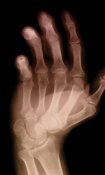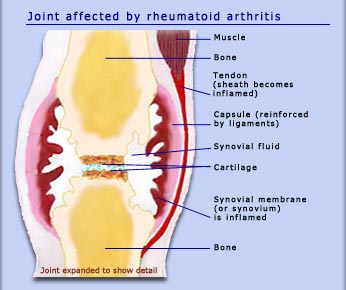|
What is rheumatoid arthritis?
 Arthritis is a general term that is used to describe inflammation of the joints in
the body. Rheumatoid arthritis (RA) is a type of chronic arthritis that occurs in varying joints such as the hands, wrists or knees and will appear in the joints
on both sides of the body at the same time. This appearance of the inflammation on both sides of the body (such as both knees, or both wrists) is
one way of identifying RA from other types of arthritis (there are more than 150 different types of arthritis). In addition to affecting the joints, RA is known to
affect organs of the body including the skin, eyes, lungs, heart, blood and kidneys. Arthritis is a general term that is used to describe inflammation of the joints in
the body. Rheumatoid arthritis (RA) is a type of chronic arthritis that occurs in varying joints such as the hands, wrists or knees and will appear in the joints
on both sides of the body at the same time. This appearance of the inflammation on both sides of the body (such as both knees, or both wrists) is
one way of identifying RA from other types of arthritis (there are more than 150 different types of arthritis). In addition to affecting the joints, RA is known to
affect organs of the body including the skin, eyes, lungs, heart, blood and kidneys.
Unlike osteoarthritis, rheumatoid arthritis is an inflammatory disease that can affect people of all ages. It usually starts in the fingers and can affect several
simultaneously. Some people may suffer from only one attack of this disease in their lives. In others, the disease may be long-term and progressive and in others it may progress rapidly.
It is 3 times more common in women than men and usually occurs in people aged from 25—50 years. However, young children and the elderly can develop the condition.
The cause of rheumatoid arthritis is not fully understood. However, it is thought to be caused by a combination of genetic, environmental and hormonal factors.
 What are the symptoms of rheumatoid arthritis? What are the symptoms of rheumatoid arthritis?
- General feeling of ill-health.
- Pain in the affected joints.
- Swelling of the joints.
- Stiffness, which restricts movement, especially early in the morning.
How is rheumatoid arthritis diagnosed?
There are a number of different ways to diagnose rheumatoid arthritis, with
diagnosis usually decided with a combination of the following:
- the specific location of the painful joints and if they affect both sides of the body (called symmetry);
- the presence of stiffness and pain in the joints in the morning;
- the presence of bumps and nodules under the skin (called rheumatoid nodules);
- results of X-rays that show inflammation or damage to the joints; and
- positive results of a blood test for RA to identify the rheumatoid factor in the blood, however, this is not conclusive as the rheumatoid factor may be present in people who do
not have rheumatoid arthritis.
What you can do
 Apply VITAFON Apparatus Vibroacoustic's Vibraphones after
selecting the related pre-progranmed operation on the sick aria. Folow the instruction manual for treatment sessions. Apply VITAFON Apparatus Vibroacoustic's Vibraphones after
selecting the related pre-progranmed operation on the sick aria. Folow the instruction manual for treatment sessions.
- Rest the joint until the pain subsides, then resume normal activities to prevent stiffness.
- Keep the joint warm at night and in cold weather.
- Gentle exercise, such as swimming in heated swimming pools, can be of help.
However, a balance of rest and exercise is important. When there is a worsening of the joint inflammation. When the inflammation decreases, gentle
exercise is needed to maintain mobility in the joint and to strengthen the surrounding muscles. .
|